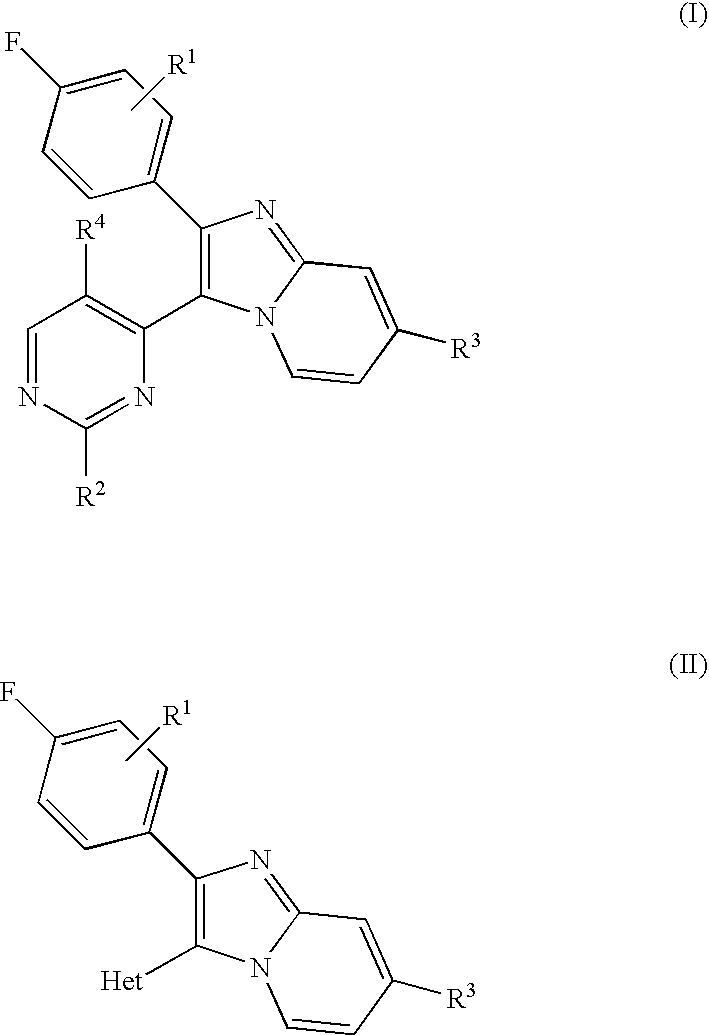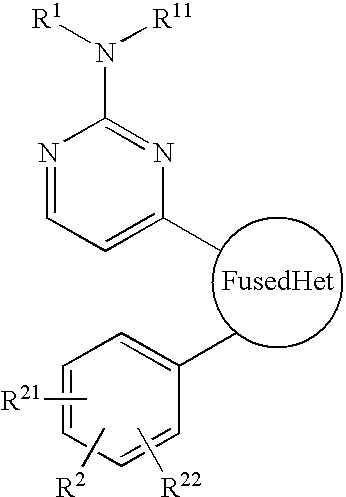Antiprotozoal imidazopyridine compounds
a technology of imidazopyridine and compound, which is applied in the field of imidazopyridine compounds, can solve the problems of malaria remaining a significant health threat to humans, anticoccidial agents such as sulfanilamides, nitrofurans, benzoamides, etc., and achieve the effect of treating protozoal diseases and protozoal diseases
- Summary
- Abstract
- Description
- Claims
- Application Information
AI Technical Summary
Benefits of technology
Problems solved by technology
Method used
Image
Examples
example 1
2-(4-Fluorophenyl)-7-(1-methylpiperidin-4-yl)-3-(2-methylpyrimidin-4-yl)imidazo[1,2-a]-pyridine
[0140]
Step 1. A 2.0 L round bottom flask was charged with 4-fluorophenacyl chloride (100 g, 579 mmol), then methanol (1.0 L), then O-methylhydroxylamine HCl (96.8 g, 1.56 mol), and the mixture was heated to 65° C. for 2 hours. The reaction was then concentrated under reduced pressure, then charged with acetone (750 mL), and lithium bromide (252 g, 2.90 mol), and the mixture was heated to 60° C. for 16 hours. The reaction was then concentrated under reduced pressure, suspended in 1.0 L methylene chloride, and washed with 3×200 mL water. All organic extracts were then pooled; dried over Na2SO4, filtered, and concentrated under reduced pressure to yield 2-bromo-1-(4-fluorophenyl)ethanone O-methyloxime (118 g, 83%). 1H NMR (500 MHz, CDCl3) δ 4.10 (s, 3H), 4.35 (s, 2H), 7.11 (t, J=8.8 Hz, 2H), 7.72 (m, 2H). MS (ESI+) 246.0.
Step 2. A 2.0 L round bottom flask was charged with 4-(piperidin-4-yl)py...
example 2
7-(1-Ethylpiperidin-4-yl)-2-(4-fluorophenyl)-7-3-(2-methylpyrimidin-4-yl)imidazo[1,2-a]-pyridine
[0141]
[0142]2-(4-fluorophenyl)-3-(2-methylpyrimidin-4-yl)-7-piperidin-4-ylimidazo[1,2-a]-pyridine (Example 1, Step 7, 300 mg, 0.774 mmol) was dissolved in methanol (5 mL), and charged with acetic acid (300 μL), acetaldeyhyde (0.85 mmol, 48 μL), and NaBH3CN (0.929 mmol of a 1.0M solution in THF, 929 μL). After stirring for 15 minutes at room temperature, the reaction was quenched with 1 mL concentrated ammonium hydroxide, then purified via 6×1.0 mL injections onto a reverse phase HPLC column using a gradient that started with 40% methanol: 60% 0.1% Et3N in water and ended with 100% methanol. Fractions containing desired product were pooled and concentrated under reduced pressure to provide the title compound (119 mg, 37%). 1HNMR (400 MHz, CDCl3) δ 1.15 (t, J=7.2 Hz, 3H), 1.94 (m, 4H), 2.10 (m, 2H), 2.50 (m, 2H), 2.63 (m, 1H), 2.81 (s, 3H), 3.13 (m, 2H), 6.90 (dd, J=7.4, 1.9 Hz, 1H), 6.94 (...
example 3
2-{4-[2-Fluorophenyl-3-(2-methylprirmidin-4-yl)imidazo[1,2-a]pyridin-7-yl]piperidin-1-yl}-ethanol
[0143]
[0144]2-(4-fluorophenyl)-3-(2-methylpyrimidin-4-yl)-7-piperidin-4-ylimidazo[1,2-a]-pyridine (Example 1, Step 7, 150 mg, 0.387 mmol) was dissolved in ethanol (10 mL), and charged with 2-chloroethanol (0.46 mmol, 37 mg, 31 μL), sodium iodide (0.04 mmol, 6 mg), and potassium carbonate (0.968 mmol, 134 mg), and the mixture was heated to 90° C. for 36 hours. The reaction was diluted with 200 mL methylene chloride, then washed with 100 mL saturated aqueous NaHCO3 solution. The aqueous phase was then back extracted with 2×100 mL methylene chloride. The organic fractions were then pooled, dried over Na2SO4, filtered, and concentrated under reduced pressure. The fractions were then dissolved in a minimum volume of methylene chloride, injected onto an Isco RediSep 40 g normal phase cartridge, and eluted with a gradient that started with 100% methylene chloride and ended with 100% 90:9:1 meth...
PUM
| Property | Measurement | Unit |
|---|---|---|
| volume | aaaaa | aaaaa |
| resistance | aaaaa | aaaaa |
| concentration | aaaaa | aaaaa |
Abstract
Description
Claims
Application Information
 Login to View More
Login to View More - R&D
- Intellectual Property
- Life Sciences
- Materials
- Tech Scout
- Unparalleled Data Quality
- Higher Quality Content
- 60% Fewer Hallucinations
Browse by: Latest US Patents, China's latest patents, Technical Efficacy Thesaurus, Application Domain, Technology Topic, Popular Technical Reports.
© 2025 PatSnap. All rights reserved.Legal|Privacy policy|Modern Slavery Act Transparency Statement|Sitemap|About US| Contact US: help@patsnap.com



